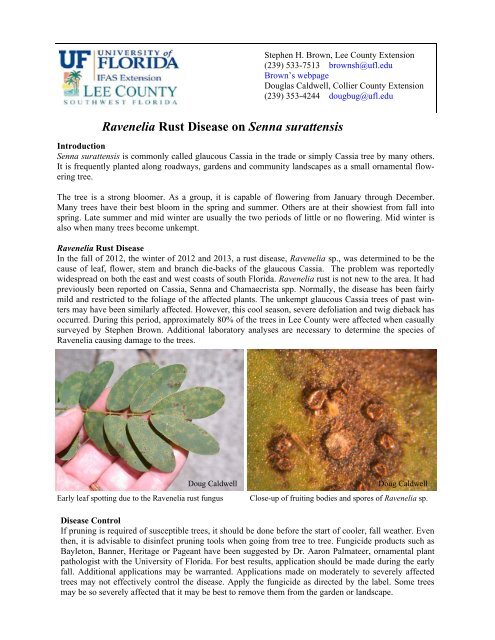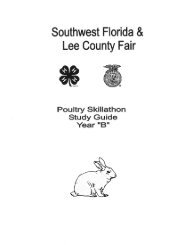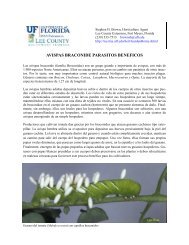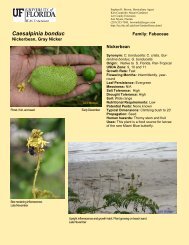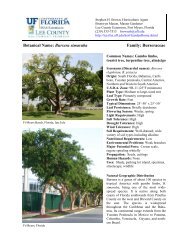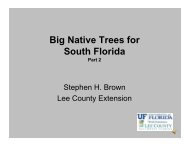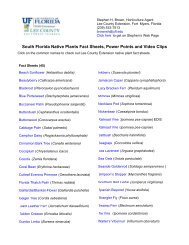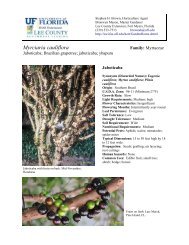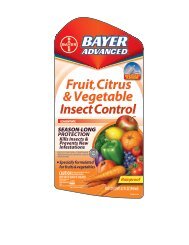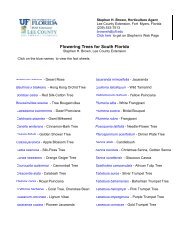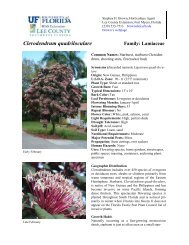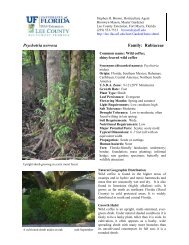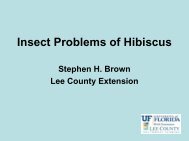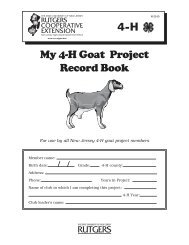Senna/Cassia Rust - Lee County Extension - University of Florida
Senna/Cassia Rust - Lee County Extension - University of Florida
Senna/Cassia Rust - Lee County Extension - University of Florida
Create successful ePaper yourself
Turn your PDF publications into a flip-book with our unique Google optimized e-Paper software.
Stephen H. Brown, <strong>Lee</strong> <strong>County</strong> <strong>Extension</strong><br />
(239) 533-7513 brownsh@ufl.edu<br />
Brown’s webpage<br />
Douglas Caldwell, Collier <strong>County</strong> <strong>Extension</strong><br />
(239) 353-4244 dougbug@ufl.edu<br />
Ravenelia <strong>Rust</strong> Disease on <strong>Senna</strong> surattensis<br />
Introduction<br />
<strong>Senna</strong> surattensis is commonly called glaucous <strong>Cassia</strong> in the trade or simply <strong>Cassia</strong> tree by many others.<br />
It is frequently planted along roadways, gardens and community landscapes as a small ornamental flowering<br />
tree.<br />
The tree is a strong bloomer. As a group, it is capable <strong>of</strong> flowering from January through December.<br />
Many trees have their best bloom in the spring and summer. Others are at their showiest from fall into<br />
spring. Late summer and mid winter are usually the two periods <strong>of</strong> little or no flowering. Mid winter is<br />
also when many trees become unkempt.<br />
Ravenelia <strong>Rust</strong> Disease<br />
In the fall <strong>of</strong> 2012, the winter <strong>of</strong> 2012 and 2013, a rust disease, Ravenelia sp., was determined to be the<br />
cause <strong>of</strong> leaf, flower, stem and branch die-backs <strong>of</strong> the glaucous <strong>Cassia</strong>. The problem was reportedly<br />
widespread on both the east and west coasts <strong>of</strong> south <strong>Florida</strong>. Ravenelia rust is not new to the area. It had<br />
previously been reported on <strong>Cassia</strong>, <strong>Senna</strong> and Chamaecrista spp. Normally, the disease has been fairly<br />
mild and restricted to the foliage <strong>of</strong> the affected plants. The unkempt glaucous <strong>Cassia</strong> trees <strong>of</strong> past winters<br />
may have been similarly affected. However, this cool season, severe defoliation and twig dieback has<br />
occurred. During this period, approximately 80% <strong>of</strong> the trees in <strong>Lee</strong> <strong>County</strong> were affected when casually<br />
surveyed by Stephen Brown. Additional laboratory analyses are necessary to determine the species <strong>of</strong><br />
Ravenelia causing damage to the trees.<br />
Doug Caldwell Doug Caldwell<br />
Early leaf spotting due to the Ravenelia rust fungus Close-up <strong>of</strong> fruiting bodies and spores <strong>of</strong> Ravenelia sp.<br />
Disease Control<br />
If pruning is required <strong>of</strong> susceptible trees, it should be done before the start <strong>of</strong> cooler, fall weather. Even<br />
then, it is advisable to disinfect pruning tools when going from tree to tree. Fungicide products such as<br />
Bayleton, Banner, Heritage or Pageant have been suggested by Dr. Aaron Palmateer, ornamental plant<br />
pathologist with the <strong>University</strong> <strong>of</strong> <strong>Florida</strong>. For best results, application should be made during the early<br />
fall. Additional applications may be warranted. Applications made on moderately to severely affected<br />
trees may not effectively control the disease. Apply the fungicide as directed by the label. Some trees<br />
may be so severely affected that it may be best to remove them from the garden or landscape.
Seasonal Recovery<br />
By mid-January <strong>of</strong> 2013, many untreated Ravenelia rust affected trees were recovering from the disease.<br />
New growth began appearing on all parts <strong>of</strong> the stems not killed by the disease.<br />
Top <strong>of</strong> rust affected leaf Bottom <strong>of</strong> rust affected leaf Dieback <strong>of</strong> leaves<br />
Recovering glaucous <strong>Cassia</strong>, late January
Recovery <strong>of</strong> Untreated Trees<br />
3 January<br />
16 January<br />
7 February
D. Zachau<br />
Before the rust: Mid December, 2011 After the rust the following year: Mid December, 2012<br />
Useful Links<br />
Anthracnose<br />
Eugenia, Ligustrum, Oleander Disease<br />
Fusarium Wilt Symptoms <strong>of</strong> Queen Palm<br />
Guava <strong>Rust</strong> on Eugenia and Simpson’s Stopper<br />
Indian Hawthorn Diseases<br />
<strong>Senna</strong> surattensis<br />
Slime Mold in the Garden<br />
Stinkhorns<br />
All pictures were taken by Stephen H. Brown except where indicated<br />
D. Zachau<br />
This fact sheet was reviewed by Dr. Aaron Palmateer; Peggy Cruz and Karen Headlee, <strong>Lee</strong> <strong>County</strong> <strong>Extension</strong>;<br />
Pat Rooney, <strong>Lee</strong> <strong>County</strong> Master Gardener<br />
The Institute <strong>of</strong> Food and Agricultural Sciences (IFAS) is an Equal Opportunity Institution authorized to provide research, educational information<br />
and other services only to individuals and institutions that function with non-discrimination with respect to race, religion, age, disability,<br />
sex, sexual orientation, martial status, national origin, political opinions or affiliations. U.S. Department <strong>of</strong> Agriculture, Cooperative <strong>Extension</strong><br />
Service, <strong>University</strong> <strong>of</strong> <strong>Florida</strong>, IFAS, <strong>Florida</strong> A. & M. 2/2013.


